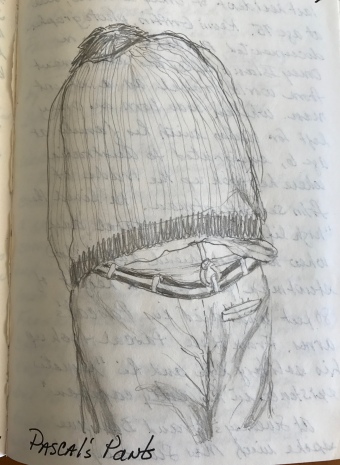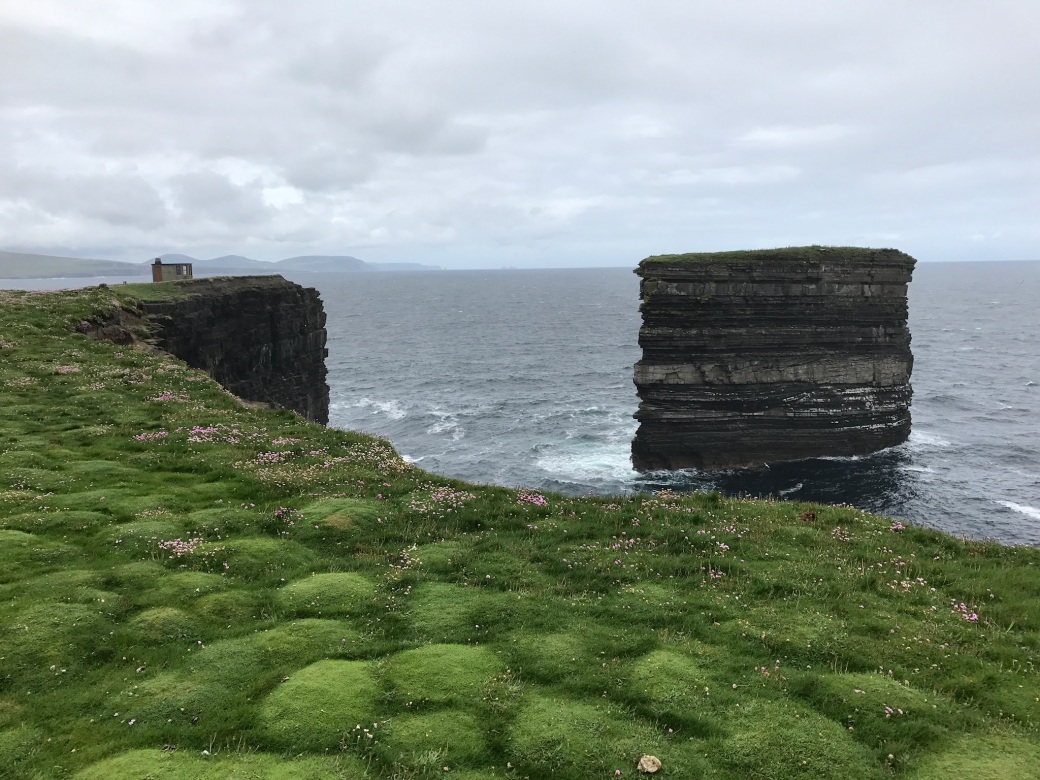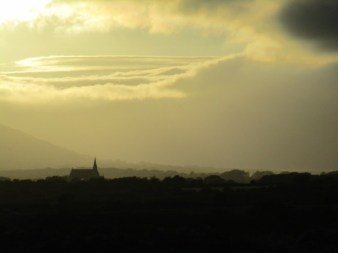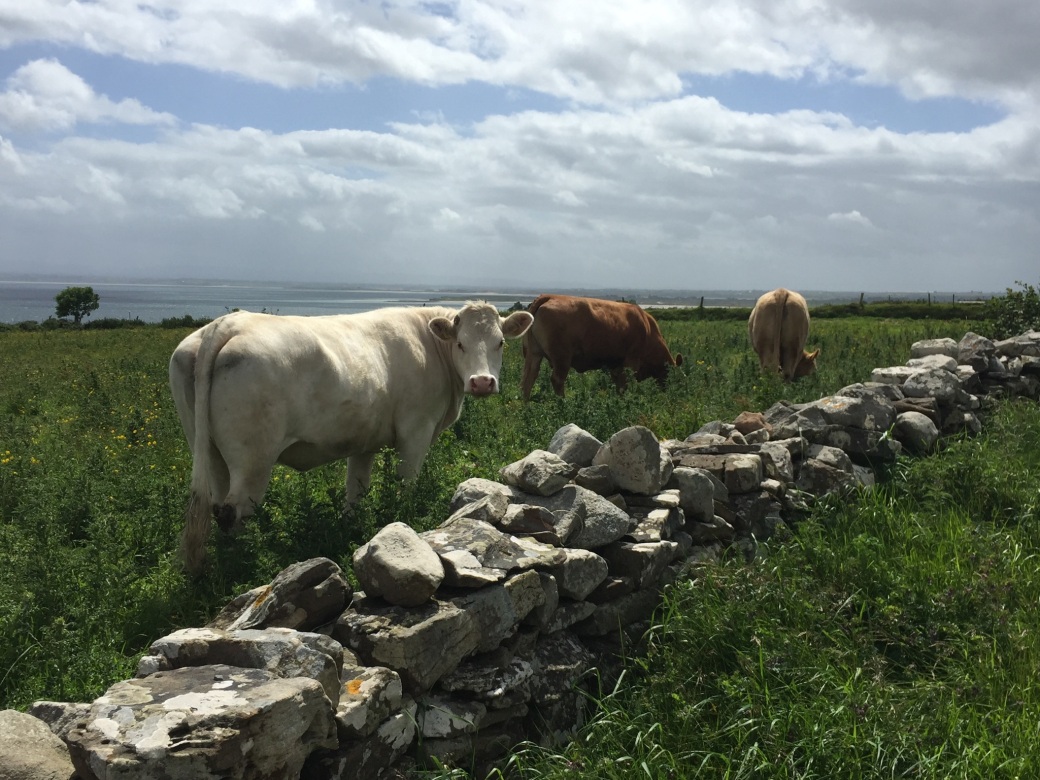This is a blog by committee, a wonderful concept that taps the unique experiences and focus of each of us. We’ve decided to post by themes. This post is a chronology of our trip, a framework for future posts.
Thurs. June 8 – Mary, Linda and Deb arrived in Dublin after an overnight flight. Stayed at the Waterloo Lodge. Attempted to combat jet lag with a long walk through Dublin, battered by a thunderstorm, fortified by tea, scones (at Queen of Tarts), beer and fish and chips (at Searson’s Pub). Alanna was in Ballycastle, County Mayo, at a print making workshop since the Sunday before.
Fri. June 9 – Picked up our trusty chocolate brown Skoda at the Dublin Airport around noon after the adventure of the lost black bag. Lunch and fabulous tours of Newgrange and Knowth. We weren’t on the road West until after 5pm. We arrived at Fuchsia Cottage just before dark and just before the big rain and wind hit. A magenta storm according to Mary’s weather app. The house was rattling but we were cozy and warm. The next morning was windy but clear. We walked the wide, sandy beach and looped back to Fuschia Cottage. The next day, wet and gray, we braved the walk to Kilcummin pier, the scene of Wolf Tone’s short-lived rebellion against the British in coordination with French revolutionaries, 1798. We walked in wind and rain accompanied by Conor the dog and a busy border collie. We lit the turf fire when we got back and dried our clothes by its radiant heat. We had dinner and Jack the Lad ale at the Village Inn in Killala.

Kilcummin Beach

Kilcummin Pier

Conor the dog and friend

Fuschia Cottage hearth
Sun. June 11 – After a windblown visit to Ceide Fields, we had dinner with Alanna and her fellow class participants at Ballycastle Art Centre.

Ceide Fields visitor center

Unearthed bronze age fences
Mon. June 12 – Mary, Deb and Linda visited Downpatrick Head, windy as usual, but clear and no rain. Lovely hummocky bog land and stunning cliffs to turquoise ocean. We picked up Alanna and headed to Clifden with a stop in Newport for a great lunch at Kelly’s Kitchen. We scored cozy felt smurf slippers in a craft shop. We drove the skinny, precipitous road to Achill Island all the way to Keem Strand. Basking shark fishing took place here. The liver oil fueled the lamps of Dublin. This is the land of Grace O’Malley the Pirate Queen (1530-1600), queen of Clew Bay.

Downpatrick Head

Kelley’s Kitchen, Newport

The crumbling home of the Pirate Queen

Clifden craft

Newport smurf slippers

Above Keem Bay
We arrived in Clifden around 8pm and settled into the Clifden Lighthouse Dwelling. It’s an old building, a little tired, but an easy 5 minute walk into Clifden. Clifden was a good base to stock up on food and engage in some retail therapy. Deb and Linda drove out to Omey Island at low tide. We walked across the sand to the island, beach combed and cairn constructed and visited the church ruins in a sheltered hollow, hidden from pirates. We had a lovely lunch of veg soup and seafood chowder at Sweeney’s. We learned about Pascal, the last man standing on Omey Island.

Omey Island beach

Moving the cows at low tide

Teampaill Feichin, medieval church

Crocan na Mban

Omey Is. Maiden’s cairn

The staffs of life: cappucino and Guinness at Sweeney’s
Deb, Mary and Alanna drove out to Roundstone and hiked a bit in the bog. We found a wonderful craft center where Alanna fell under the spell of Malachy the bohdran builder. After a walk on the white sands of Dog’s Bay, we met Pat the pony man. He took us to his horse barn and introduced us to three generations of well-bred Connemara ponies. Some important trans-Atlantic firsts around Clifden: Marconi exchanged the first trans-Atlantic radio message here in 1907. Alcock and Brown completed the first non-stop flight across the Atlantic in 1919, crash landing in the bog near the radio station.

Alanna and Mary at Dog’s Bay

Pat and Independence, a champion Connemara pony

Taking a bite of Marconi peat turf
Thurs. June 15 – We drove to Rosaveel, parked the car and caught the 10:30 ferry to Inishmor. We stayed at the cozy Pierhouse. Windy and gray, but not much rain. We toured the island with lying Bertie Flaherty and walked out to the Dun Aengus fort. We walked to dinner and music at Joe Watty’s pub. Next morning we explored the island and caught the 4pm ferry back to the mainland. We drove around Galway bay and got to Ballyvaugh and Stone House around 7pm. A sigh of relief: home base for 6 days.

Jow Watty’s Pub for music and good eats

Irish Blue Grass at Joe Watty’s

Na Seacht d’ Teampaill-the 7 Churches

Pierhouse BnB

Nan Phaidi’s home of Guiness Stew and Crabcakes

Fort with a view

Dun Aonghasa on the edge

Dun Aonghasa path

Breaching the fort

Solid stone walls
June 16-June 21– Stone House. The weather finally cleared for us. It’s a magical place, the Burren hills on one side, Galway Bay on the other, easy walk to town and a lovely loop walk right out the door. We had a most perfect visit to the Cliffs of Moher, warm, still, endless visibility. We caught some spontaneous music in Doolin at O’Connor’s Pub. It was a weekend folk festival so lots of musicians hanging about. Kathleen and Danny, Don’s cousins, stayed at a BnB in Fanore. We shared meals and long walks with them. Cousin JP came drove from Tuam for dinner two nights. Emily and Eric joined us for a night and got to meet the Irish relatives. We had a serendipitous meeting with John O’Donohue’s sister in law, a friend of Noel’s and she connected us to a most perfect Solstice choral concert at the church in Ballyvaughn. So many rich experiences for all of us here. We needed at least another week.

Failte

Cliffs of Moher

Burren in the evening light

Danny the pathfinder

The crest of Sliabh Eilbhe

O’Connor’s Pub in Doolin

Our path on this trip

Sweetest pub in Ireland

Cliffs of Moher on a perfect day

Gathering the clan

A wee nip at O’Laichlan’s

The navigators

Caution: Loose Hens

Stone House sunset

Our baby
June 22- Dublin airport hotel, last pint at the pub. Up at 3:15 the next morning for the trip home. And then begins the re-entry to the real world, trying to savor and imprint in our memories the many rich experiences of our Irish journey.

Wood Loop sunset

Old Pier Ballyvaughn

Wood Loop evening walk

Lismorahaun Singers Summer Solstice concert

St John’s Church, Ballyvaughn

Leaving Stone House

Stone House heaven

The parting glass

Says it all

 printmaking workshop at the Ballinglen Arts Foundation before Mary, Linda, & Deb joined me. The instructor,
printmaking workshop at the Ballinglen Arts Foundation before Mary, Linda, & Deb joined me. The instructor,  Travel for the sake of travel is not my thing (see my post
Travel for the sake of travel is not my thing (see my post  I am engaged. In the past, Spanish language immersions with homestays gave me the opportunity to experience Mexico & Central America on an intimate level.
I am engaged. In the past, Spanish language immersions with homestays gave me the opportunity to experience Mexico & Central America on an intimate level. home and immerse myself in creativity for a good week. I was fortunate to discover
home and immerse myself in creativity for a good week. I was fortunate to discover 


 Humanity around the world has its differences in what holidays are celebrated. The one thread that unites us is the changing of seasons. Most cultures have some kind of observance for the seasonal markers around the equinoxes and solstices such as Harvest, Halloween, Day of the Dead, Christmas, Hanukah, Easter & so forth. In Northern climates, the Summer Solstice, or
Humanity around the world has its differences in what holidays are celebrated. The one thread that unites us is the changing of seasons. Most cultures have some kind of observance for the seasonal markers around the equinoxes and solstices such as Harvest, Halloween, Day of the Dead, Christmas, Hanukah, Easter & so forth. In Northern climates, the Summer Solstice, or Midsummer’s Eve is cause for celebration. On the longest day of the year, there is a little magic & love is in the air.
Midsummer’s Eve is cause for celebration. On the longest day of the year, there is a little magic & love is in the air. most lovely event, a choral concert in the local church in the village of Ballyvaughan put on by the Lismorahuan Singers. In the choir were the smiling faces of numerous local faces we had gotten to know during our week long stay there. What a perfect way to spend our last night in Ireland- worthy of a poem.
most lovely event, a choral concert in the local church in the village of Ballyvaughan put on by the Lismorahuan Singers. In the choir were the smiling faces of numerous local faces we had gotten to know during our week long stay there. What a perfect way to spend our last night in Ireland- worthy of a poem.

























































































